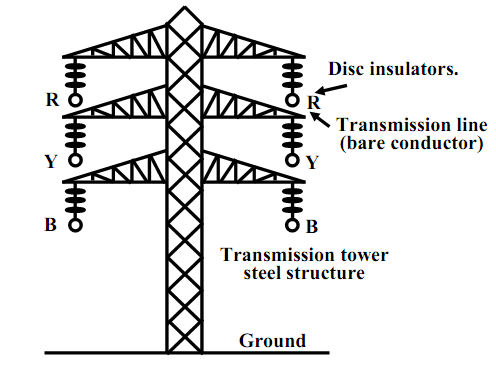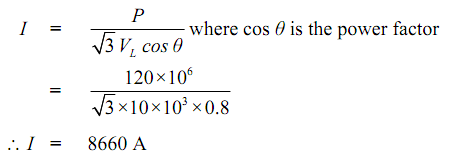Transmission of power
The enormous quantity of power generated in a power station (i.e., hundreds of MW) is to be transported over a long distance (i.e., hundreds of kilometers) to load centers to cater power to consumers with the help of transmission line and transmission towers as shown in figure below.

Figure: Transmission tower.
To offer an idea, let us consider a generating station generating 120 MW power and we desire to transmit it over a large distance. Suppose the voltage produced (i.e., line to line) at the alternator be 10 kV. Subsequently to transmit 120 MW of power at 10 kV, current in the transmission line is simply computed by using power formula for 3-phases as follows:

Rather of selecting 10 kV transmission voltage, when transmission voltage were selected to be 400 kV, current value of the line would have been around 261.5 A. Therefore sectional area of the transmission line (i.e., copper conductor) will now be very smaller as compared to 10 kV transmissions voltage. In another words the cost of conductor will be greatly decreased when power is transmitted at higher and higher transmission voltage. The use of higher voltage (therefore lower current in the line) decreases voltage drop in the line resistance and reactance. Also the transmission losses are decreased. The standard transmission voltages employed are 132 kV or 220 kV or 400 kV or 765 kV based upon how long the transmission lines are.
Hence after the generator we should have a step up transformer to change the produced voltage (let say 10 kV) to preferred transmission voltage (let say 400 kV) before transmitting it over a long distance with the help of transmission lines supported at regular intervals by transmission towers. It must be noted that whereas magnitude of current decides the price of copper, level of voltage chooses the cost of insulators. The thought is, in a spree to decrease the cost of copper one cannot indefinitely raise the level of transmission voltage as cost of insulators will offset the decrease copper cost. At the load centers voltage level must be brought down at appropriate values for supplying various types of consumers. Consumers might be
(A) big industries, like steel plants,
(B) medium and small industries and
(C) offices and domestic consumers.
Electricity is buying by various consumers at diverse voltage level. For illustration big industries might purchase power at 132 kV, average and big industries purchase power at 33 kV or 11 kV and the domestic consumers at instead low voltage of 230V, single phase. Therefore we see that 400 kV transmission voltages are to be brought down to various voltage levels before lastly delivering power to various consumers. To do this we need clearly step down transformers.